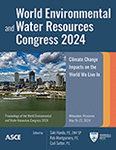Stormwater Management Using Low Impact Developments (LIDs): Case Study from Juniata College, Huntingdon, PA
Publication: World Environmental and Water Resources Congress 2024
ABSTRACT
The city of Huntingdon is a small town located in Central Pennsylvania. The town is served by a stormwater management system that has aged. This often has led to flooding in parts of the city and sewer overflow into the local creeks. This study aims to assess and manage the urban runoff for the town while the current focus is only on Juniata College. Juniata College is a liberal arts institution situated at the heart of town with a total area of 110 acres and represents a major developed area in the town. Most importantly, a local creek, named Muddy Run, passes through Juniata College and carries runoff from residence halls and parking lots. Various places on campus with runoff issues were identified. The places of concern were first selected based on the previous flooding history, and those sites were visited after rain events during the year 2022/2023 for a better understanding of the current runoff scenario. Flood factor and NOAA flood maps were used as additional tools in selecting the sites of concern. An extensive review of the successful cases of low impact developments (LIDs) in similar situations was conducted. EPA Stormwater Calculator was then used to assess the merits of proposed LID implementations for Juniata College. The study also aims to explore ideas and ways for the reuse of captured water and its added benefits to the college on water consumption, cost, and sustainability efforts.
Get full access to this chapter
View all available purchase options and get full access to this chapter.
REFERENCES
Almeida, A. P., Silva, C. M., and Sousa, V. (2021). Dynamic modelling of rainwater harvesting with green roofs in university buildings. Journal of Cleaner Production, Volume 312. Retrieved from (https://www.sciencedirect.com/science/article/pii/S0959652621018734).
(2010). Chapter 7, Appendix A - Field manual for Pennsylvania Design Rainfall Intensity Charts from NOAA Atlas 14 Version 3 Data.
Darner, R. A., and Dumouchelle, D. H. (2011). Hydraulic characteristics of low-impact development practices in northeastern Ohio, 2008–2010. U.S. Geological Survey Scientific Investigations Report 2011-5165, 19 p.
EPA. (2023, June 8). Retrieved from Using Green Roofs to Reduce Heat Islands: https://www.epa.gov/heatislands/using-green-roofs-reduce-heat-islands.
Fernández-Cañero, R., Emilsson, T., Fernandez-Barba, C., and Herrera Machuca, M. Á. (2013). Green roof systems: a study of public attitudes and preferences in southern Spain. Journal of environmental management, 128, 106–15.
Kim, J., and Ryu, J. H. (2020). Decision-Making of LID-BMPs for Adaptive Water Management at the Boise River Watershed in a Changing Global Environment. In Urban Water Management.
Mentes, J., Raes, D., and Hermy, M. (2006). Green roofs as a tool for solving the rainwater runoff problem in the urbanized 21st century. Landscape and Urban Planning, 217–226. doi:https://doi.org/10.1016/j.landurbplan.2005.02.010.
National Stormwater Calculator. (2022, August 10). Retrieved from United States Environmental Protection Agency : https://www.epa.gov/water-research/national-stormwater-calculator.
Pour, S. H., Abd Wahab, A. K., Shahid, S., Asaduzzaman, M., and Dewan, A. (2020). Low impact development techniques to mitigate the impacts of climate-change-induced urban floods: Current trends, issues and challenges. In Sustainable Cities and Society (Vol. 62).
Rahman, M. A., Imteaz, M., and Arulrajah, A. (2016). Suitability of reclaimed asphalt pavement and recycled crushed brick as filter media in bioretention applications. 15. 32–48. https://doi.org/10.1504/IJESD.2016.073333.
Rawls, Brakensiek, and Saxton. (1982). Estimation of Soil Water Properties, Transactions American Society of Agricultural Engineers 25(5): 1316–1320, 1328.
Ritchie, H., and Roser, M. (2019, November). Urbanization. Retrieved from Our World in Data: https://ourworldindata.org/urbanization.
Soil Map. (n.d.). Retrieved from Web Soil Survey: https://websoilsurvey.sc.egov.usda.gov/App/WebSoilSurvey.aspx.
Stormwater Calculations. (2009). In NCDENR Stormwater BMP Manual (pp. 1–58).
Types of Green Roofs. (2023). Retrieved from Soil Science Society of America: https://www.soils.org/about-soils/green-roofs/#:~:text=Semi-intensive%20green%20roofs%20have%20moderate%20watering%20and%20maintenance,as%20stormwater%20filters%20and%20habitat%20for%20urban%20wildlife.
USDA. (2007). Chapter 7 Hydrologic Soil Groups. In Part 630 Hydrology National Engineering Handbook.
Winston, R. J., Dorsey, J. D., and Hunt, W. F. (2016). Quantifying volume reduction and peak flow mitigation for three bioretention cells in clay soils in northeast Ohio. Science of The Total Environment, 553, 83–95.
Information & Authors
Information
Published In
History
Published online: May 16, 2024
ASCE Technical Topics:
- Business management
- Case studies
- Colleges and universities
- Disaster risk management
- Disasters and hazards
- Education
- Engineering fundamentals
- Environmental engineering
- Floods
- Hydrologic engineering
- Hydrology
- Methodology (by type)
- Natural disasters
- Practice and Profession
- Research methods (by type)
- Runoff
- Stormwater management
- Sustainable development
- Systems engineering
- Systems management
- Water and water resources
- Water treatment
Authors
Metrics & Citations
Metrics
Citations
Download citation
If you have the appropriate software installed, you can download article citation data to the citation manager of your choice. Simply select your manager software from the list below and click Download.
